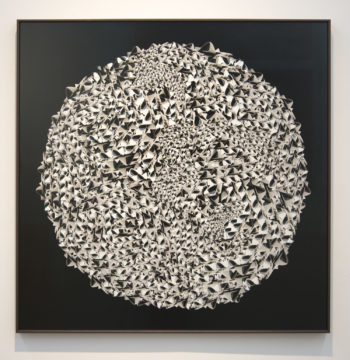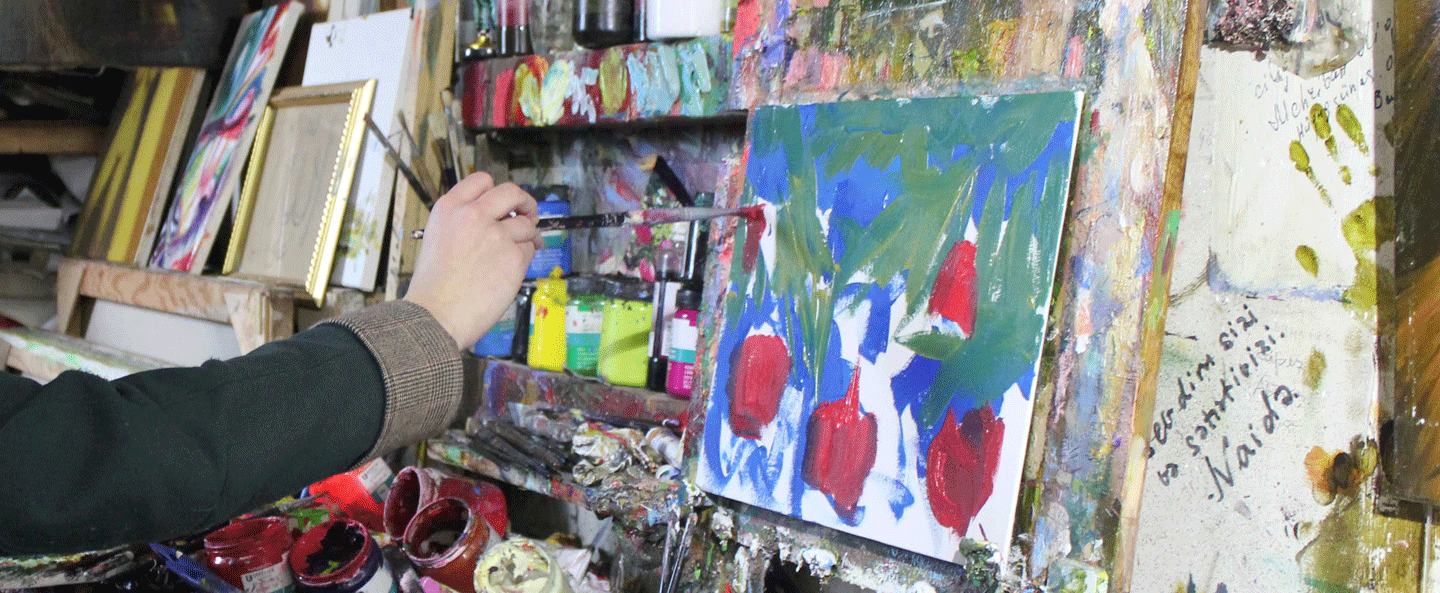
ART & DESIGN
At the heart of Azerbaijan is a rich visual culture spanning over centuries of elevation. There is a vast history of art which has influenced movements world wide and found its place within an ever-changing modern society. Azerbaijani art dates back to prehistoric era and has consistently developed into modern times providing beautiful and inspiring pieces to be seen on the international art scene.
Ancient
One of the earliest recorded pieces of art within Azerbaijan can be found in Gobustan National Park. These pieces are cave paintings and carvings and are said to date back 5000-20000 years. These paintings depict various parts of early Azerbaijani society which are illustrated through carefully produced works of early man. They show battles, farming and even dancing, some also show pictures of animals such as horses and goats indicting what early rural life may have been like. There are 6000 carvings over 40000 acres of land providing a plentiful source for historians and artists alike to study the foundations of society and the beginnings of the Azerbaijani art movement. It is now also very easy to visit and explore these antiquities through an interactive museum onsite which has opened to the public in the last decade.
Azerbaijan is also home to some of the oldest illustrations in the world: The Gamigaya Petroglyphs in the territory of Ordubad Rayon are dated back to the 1st to 4th centuries BC. To date, archaeologists have discovered about 1,500 dislodged and carved rock paintings. They have recorded images of deer, goats, bulls, dogs, snakes, birds, fantastic beings and also people, carriages and various symbols on basalt rocks throughout the area.
Traditional
Due to its close proximity to Europe, Iran and Turkey, an impressive tapestry of contrasting cultures have influence Azerbaijan. From the antiquities of the Islamic Shirvan Era (12th-14th centuries); the silk trade route bought influence to textiles and carpets from Pakistan and Uzbekistan in the east and European cultural tastes in the west; to the very different marxist Soviet Union (1920-1991), which defined an art movement of Futurism and Constructivism. Eventually, this melting pot of traditions has resulted in the profoundly unique flavour found in the country’s visual art.
Miniatures
Another branch of early Azerbaijani art is the miniature painting movement, which was also popular with the Ottoman Empires at the time for their transportability and rich use of colour and gild. Miniatures are paintings on small pieces of paper, as well as illustrations within books which express emotion and story from the artist. Miniature artists would often use symbolic colours to detail emotion and would derive certain positions and expressions in their characters in order to create a human connection to their audiences. This movement began in the 13th century and was at its height during the 15th century.
Sultan Muhamad is one example of producers of this form artwork One his more famous works, ‘Miraj’, is currently placed in the British Museum it depicts the character Rostam sleeping while Rakhsh fights a lion and was found in the book of kings.
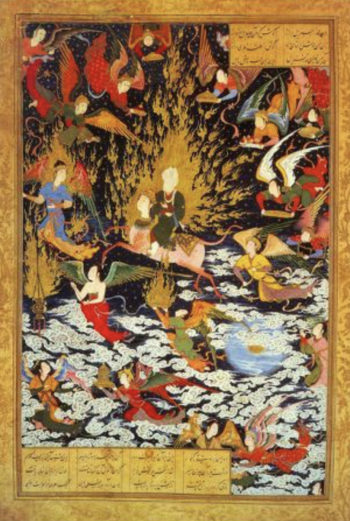
This form of art still continues today but largely sparked from artists in Azerbaijan. Artist Tim Ridley, who took part in the ‘Light Remnant’ Residency programme was inspired by miniature paintings to make his own contemporary works in Azerbaijan.
Fine Art & Galleries
A broad network of Azerbaijani museums and galleries exhibit many works of Fine Art and painting, across the country. In particular, in Baku there area several institutions dedicated to literature, fine arts, carpets, decorative arts and modern art.
National Art Museum
Built in 1981, originally as a luxury residence, the National Art Museum in Baku now holds works from across Europe, internationally and a noteworthy collection of Azerbaijani fine art works from the 1920’s to now. The Azerbaijani government transformed the museum after independence, restoring it in the 1990’s to what it is today. President Heydar Aliyev opened the Museum for its 80th anniversary, making improvements to the museum, that breathed a new lease of life in their surroundings.
The National Art Museum holds a permanent collection of traditional works from across Azerbaijan, including painting, sculpture, glass, jewellery and textiles. It has a showcase from Shusha. Susha is a town considered by many to be the cultural heart of Azerbaijan because so many poets, writers, singers and musicians came from the area. Many great artists were publicly celebrated here. For example, busts of composer Uzeyir Hajibeyov, the singer Bulbul and the poetess Natavan were once placed on display. These statues, however, sadly war damaged, have been rescued and now exhibited in the National Art Museum in Baku.
Contemporary Art Galleries
The convergence of cultures has not only lead to a diverse and tolerant culture of people, but has also led to a flourishing contemporary art scene in Baku. As the capital of Azerbaijan and the largest city in the Caucasus, Baku has much to offer due to its unusual mixture of cultures and traditions.
Artists of note include Sattar Bahlulzade (1909–74) and Tair Salakhov (1928). Bahlulzade founded contemporary Azerbaijani landscape painting. He represented the countryside of his homeland in an impressionistic style, combining pastel colours and broad strokes. He has exhibited work across the world. Salakhov is, in contrast, known for his adorned, ‘severe – style’ of depicting celebrities across the 20th century.
Baku offers and abundance of galleries and opportunities for young people to get involved in the fine arts. The Museum of Modern Art which lies in the centre of Baku is the collection of the best works of painting and sculpture of Azerbaijan’s avant-guard artists of the 20th century up to now. The gallery describes itself as having a collection that shows “aspirations, strivings and freedom of human soul”. There is a set collection of works that range from European contemporaries such as Picasso to Azerbaijani contemporaries such as Tair Salakhov.
The Yarat Contemporary Gallery has a revolving show of international contemporary artists. It lies in the centre of a new cultural district by The Crystal Palace (Eurovision) and the European Games stadium. It boasts festivals, events, interactive tours and speaks about risqué topics in its cutting edge touring shows. The gallery also funds a smaller gallery in the centre of Baku called ‘YAY’ – this funds young emerging Azerbaijani contemporaries.
Links
azerbaijan.az
Contemporary Azerbaijan Art & Artists
Soviet Influence
In the 1920s new art forms began to develop from within Soviet controlled Azerbaijan. Sattar Bahlulzade is an example of an expressive painter from this period, with the national title of the father of ‘Azerbaijani Landscape’. Although working in a realistic and traditional method to begin with, his work developed to have a more abstract style over time – you could compare Bahlulzade’s work with impressionist works in development in Western Europe at the time, the artist giving Azerbaijan a similar tranquility to the Azerbaijani people with his work. He described his works with having a cosmic style using mainly pastel colours and bold strokes to bring a sense of life to his works. The images often depicted Azerbaijan landscapes including popular mountain scenes from the Grand Caucasus Mountains. His work continued to gain popularity, even after his death, featuring in various exhibitions. Bahlulzade’s work even travelled worldwide in the form of national stamps – such as this Ancient Shamaka Stamp:
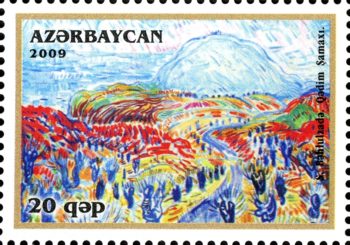
Moving into the second half of the 20th century, artist Tahir Salahov was a pioneer in Azerbaijan of an art form known as severe realism. This popular movement intended to remove the polished view of communism which Stalin had rigorously enforced. Using a palette largely of red, black and varying shades of grey, Salahov would paint industrial workers such as in the painting ‘Repairmen’ which depicts oil workers from Baku’s heavy and overpowering industry in the union. His works sometimes varied – in his earlier works he experimented with differing pictures of workers such as his first well known piece ‘The shift is over’ to varied industrial buildings like in the work ‘At The Caspian Sea’; he also worked over time on very detailed portraits. His works spark a sense of realism which many are familiar with the darker undertones of life clearly apparent.
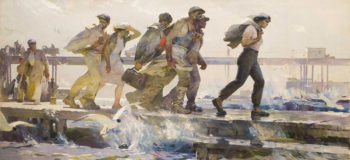
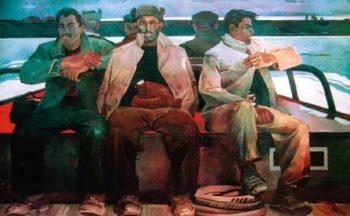
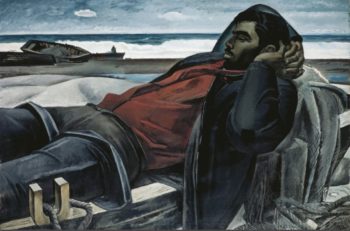
21st Century Artists
With further development in technology, new art forms are continuously developed and experimented with. Azerbaijani artists have been able to develop a freedom within their styles which allows them to produce distinct works in both traditional and non-traditional forms.
Fakhriyya Mammadova
Photography is on the rise as a Popular modern art form. Artist Fakhriyya Mammadova is a photographer from Baku who experiments with the medium through macro photography. Macro Photography is a technique which focuses on small subjects enlarging them in a snapshot to unmask minuscule detail and bring the subject to central focus. Mammadova uses her art form to focus on Azerbaijani life. Her series of work ‘Girlish Dreams’ features different aspects of a woman getting married under a traditional Azeri wedding, the different camera positions providing both intimate 1st person views and wider shots. The varying positions of the photos and the vast amount of them provides a clear insight into an important moment of this person’s life and cements it as part of history.
Mammadova is an artist trained in Azerbaijan and is currently represented by the ‘Yay!Gallery’ For more information about the artist, her work, and more emerging artists from Azerbaijan, please follow this link:

Faig Ahmed
Installation art is becoming an increasingly popular medium within Azerbaijani art circles, Installation art is where an artist chooses to use the whole room (or gallery) as their canvas, producing work based on where it will be displayed (site specific), it incorporates different mediums sculptures and techniques. Faig Ahmed is an installation artist very well know in Azerbaijan and across the world. Ahmed takes his inspiration from traditional Azerbaijani art mediums such as Carpet Waving (A UNESCO protected intangible heritage unique to Azerbaijan) to produce a contemporary statement on tradition. He disassembles the details within the rugs and re structures them over the installation using materials such as varied thread. Rather minimalistic in its form he provides the idea of modernisation within society and how it is sometimes better for society to move forward from the past in parallel with tradition rather than against it. Ahmed in particular wants to break society’s boundaries and move away from the stereotypes that prevents progression.
Ahmed’s work can be seen across the Baku Capital with pieces owned by the Yarat Contemporary Gallery and The Fairmont Hotel, Baku (The famous ‘Flame Towers).
To learn more about the artist and his works:
https://www.animationpagoda.com/2017/04/01/featured-artist-faig-ahmed/
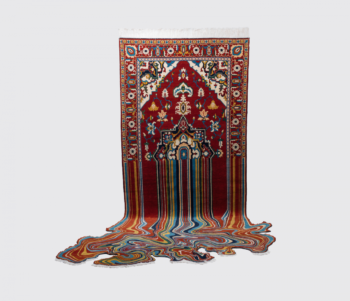
Ramal Kazim
Traditional art forms are still respected in Azerbaijan, and contemporaries utilise form with a contemporary twist. Ramal Kazim is an Azerbaijani artist who uses mixed media to produce fine art on canvases. Through more traditional materials and techniques, such as the use of charcoal, pencil and paint, Kazim presents an in-depth study of the human anatomy. Through exaggerated features, distorted images and a cold or juxtaposed colour pallet he can produce inner torment of the human form. Each piece telling a story of inner anguish which isn’t always apparent physically. Despite being abstract in style it still has a vast connection to reality and the emotions we feel as humans. Kazim is represented internationally, with his work represented in Azerbaijan, UK and Belgium exhibitions. In his Piece ‘Ballerinas’ Kazim represents beauty with an eery homage to Degas – where the dancer’s chilling facial feature make the audience uneasy with the composition. To see more of Kazim’s work, look at his portfolio at:
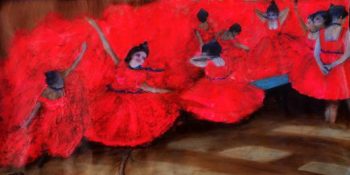
Ayten Rzaguliyeva
Emerging artist Ayten Rzaguliyeva has exhibited her work in the capital’s ‘Baku Gallery of Contemporary Art’ as well as group exhibitions across Europe. Her abstract technique of self-expression visualises itself through various landscapes and inanimate objects. She uses various mediums to create her art specialising in oils on different surfaces such as canvas wood and glass, the tones of her pieces are often warm and passive in colour welcoming those who view it.
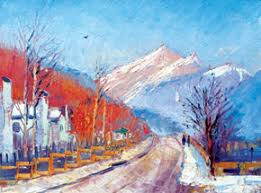
Spotlight on International Interest – Ingimar Einersson
Ingimar Einersson is an artist and designer who has drawn inspiration from contemporary Azerbaijan. He travels across the world and focuses largely on architectural collage as the main theme for his work, using colours and patterns which draw him in to gain a greater sense of what a city is about. With the use of photography and his vast use of collaging he has created multiple works of bright vibrancy that focus around his initial interests. His ‘Baku’ piece focuses on the intricacies of Zaha Hadid’s ‘Heydar Aliyev Centre’ in the centre of Baku. This is part of his ‘Capital Series’ of art works.
Einersson is an Iclandic artist whom has graduated from Chelsea College of Art and Design in London and exhibited globally.
To follow his work see:
